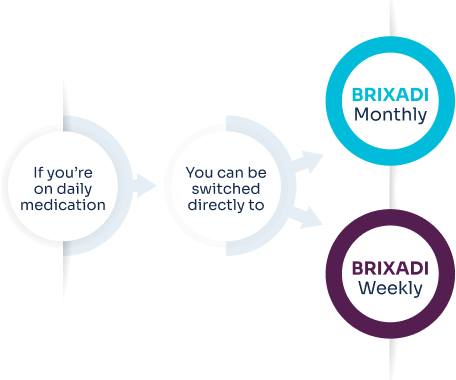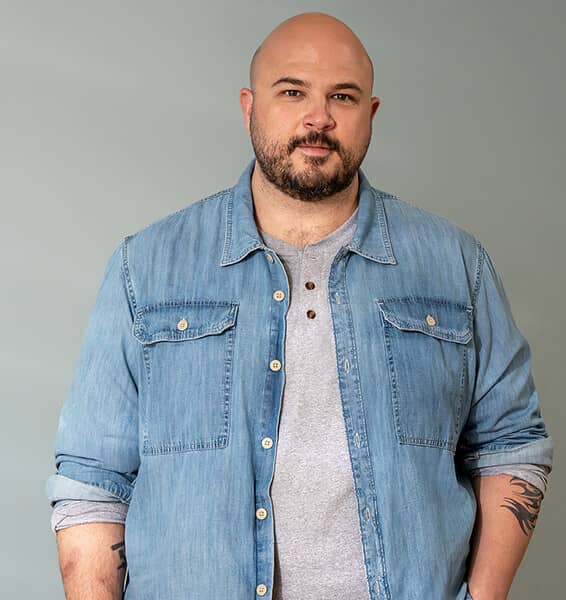BRIXADI offers individualized treatment no matter where you are on your recovery journey
If you’re just starting BRIXADI, you may have questions about your treatment
What does “individualized treatment” mean?
BRIXADI is available as a once-monthly or once-weekly injection with different dose strengths to meet your needs. You and your healthcare provider have the option of choosing between several different dosing strengths and dosing schedules that will work best for you.

What if I’m not currently taking buprenorphine?
Your healthcare provider will give you a test dose of buprenorphine as a dissolvable tablet or film before starting you on a once-weekly injection of BRIXADI to see how your body responds to buprenorphine.
How could your BRIXADI dose and dosage strength be individualized to fit your needs?

*One Suboxone® (buprenorphine and naloxone) 8 mg/2 mg sublingual tablet provides equivalent buprenorphine exposure to one Subutex® (buprenorphine HCl) 8 mg sublingual tablet or one Zubsolv® (buprenorphine and naloxone) 5.7 mg/1.4 mg sublingual tablet.
Your BRIXADI dose will be dependent on several factors:
- Your current oral buprenorphine dose
- Where you are in recovery and your goals
- Your ability to come to the office on a monthly or weekly basis
Your doctor can change your BRIXADI dose if needed.
- Works full time in construction for 5 years now
- Took prescribed pain medication after an injury but moved on to using illicit opioids
- Was prescribed oral buprenorphine to stabilize but doesn’t want to take medication every day or carry it with him
His provider recommended 128 mg of BRIXADI Monthly.

- Works in food service
- Devoted to her 2 little girls
- Her provider prescribed opioids for a chronic pain disorder. She started taking more than what was prescribed and needed help
- Began her treatment plan with oral buprenorphine but feels like the daily dosing schedule reminds her of her addiction. She also worries about her girls finding her medication
Her provider recommended 64 mg of BRIXADI Monthly.

- Works full time as a barber after earning his certification
- Has used illicit opioids in the past
- Has taken oral buprenorphine for the past 6 months but is interested in a long-acting medication
- Finds going into his provider’s office once a month is easier for his work schedule
His provider started him on 24 mg of BRIXADI Weekly and then transitioned him to 96 mg of BRIXADI Monthly.

Not actual patients.
How is BRIXADI given?
Your healthcare provider will give you your injection of BRIXADI once monthly or once weekly in their office.
You and your healthcare provider will choose which dose is right for you
BRIXADI is injected under the skin using a small needle
After BRIXADI is injected under your skin, it turns into a gel
(called a depot)
Why is this important?
1
BRIXADI has a specific formulation that uses:
- Needle size: 23G
- Depot technology: After BRIXADI is injected under your skin it turns into a gel called a depot
- Small injection volume
2
Why is this important to you?
- Small needle size: The higher the needle gauge, the smaller the needle size. For example, a 20-gauge needle is larger than a 23-gauge needle
- The depot “stores” buprenorphine medicine. It slowly releases it into your body throughout the entire month or week at a steady rate
- Small injection volume means the depot may not be noticeable under your skin
Where is BRIXADI injected?
BRIXADI can be injected under the skin in different areas of your body: buttock, thigh, stomach, or upper arm. You and your provider can determine which of these injection areas works best for you.
- If you are new to buprenorphine
The upper arm area should only be used after 4 consecutive doses (once steady state has been achieved). - If you are prescribed BRIXADI Weekly
Your healthcare provider will need to rotate sites for each injection.
Areas where BRIXADI can be injected

IMPORTANT SAFETY INFORMATION
What is the most important information I should know about BRIXADI?
- Because of the serious risk of potential harm or death from self-injecting BRIXADI into a vein (intravenously), it is only available through a restricted program called the BRIXADI Risk Evaluation and Mitigation Strategy (REMS) Program.
- BRIXADI is not available in retail pharmacies.
- Your BRIXADI injection will only be given to you by a healthcare provider.
- BRIXADI (buprenorphine) extended-release injection for subcutaneous use contains a medicine called buprenorphine. Buprenorphine is an opioid that can cause serious and life-threatening breathing problems, especially if you take or use certain other medicines or drugs.
- Talk to your healthcare provider about naloxone. Naloxone is a medicine that is available to patients for the emergency treatment of an opioid overdose. If naloxone is given, you must call 911 or get emergency medical help right away to treat an overdose or accidental use of an opioid.
- BRIXADI can cause serious and life-threatening breathing problems. Get emergency help right away if you:
- feel faint
- feel dizzy
- are confused
- feel sleepy or uncoordinated
- have blurred vision
- have slurred speech
- are breathing slower than normal
- cannot think well or clearly
- Do not take BRIXADI with certain medicines. Taking BRIXADI with other opioid medicines, benzodiazepines, alcohol, other central nervous system depressants (including street drugs) can cause severe drowsiness, decreased awareness, breathing problems, coma, and death.
- In an emergency, have family members tell the emergency department staff that you are physically dependent on an opioid and are being treated with BRIXADI.
- You may have detectable levels of BRIXADI in your body for several months after stopping treatment with BRIXADI.
Do not receive BRIXADI if you are allergic to buprenorphine or any ingredients in BRIXADI:
- BRIXADI weekly: anhydrous ethanol, soybean phosphatidylcholine, glycerol dioleate
- BRIXADI monthly: N-methylpyrrolidone, soybean phosphatidylcholine, glycerol dioleate
Before receiving BRIXADI, tell your healthcare provider about all of your medical conditions, including if you have:
- Trouble breathing or lung problems
- A curve in your spine that affects your breathing
- Addison’s disease
- An enlarged prostate (men)
- Problems urinating
- Liver, kidney, or gallbladder problems
- A history of alcoholism
- A head injury or brain problem
- Mental health problems
- Adrenal gland or thyroid gland problems
- A latex allergy. The BRIXADI needle cap contains latex.
Tell your healthcare provider if you are:
- pregnant or plan to become pregnant. If you receive BRIXADI while pregnant, your baby may have symptoms of opioid withdrawal at birth that could be life-threatening if not recognized and treated. Talk to your healthcare provider if you are pregnant or become pregnant.
- breastfeeding. BRIXADI can pass into your breast milk and may harm your baby. Talk to your healthcare provider about the best way to feed your baby during treatment with BRIXADI. Monitor your baby for increased drowsiness and breathing problems if you breastfeed during treatment with BRIXADI.
Tell your healthcare provider about all the medicines you take, including prescription and over-the-counter medicines, vitamins and herbal supplements. Talk with your healthcare provider before starting any new medicines during or after stopping treatment with BRIXADI.
What should I avoid while receiving BRIXADI?
- Do not drive, operate heavy machinery or perform any other dangerous activities until you know how BRIXADI affects you. BRIXADI can cause drowsiness and slow reaction times. BRIXADI can make you sleepy, dizzy, or lightheaded. This may happen more often in the first few days after your injection and when your dose is being changed.
- You should not drink alcohol or use prescription or over-the-counter medicines that contain alcohol during treatment with BRIXADI, because this can lead to loss of consciousness or even death.
What are the possible side effects of BRIXADI?
BRIXADI can cause serious side effects, including:
- Trouble breathing. Taking BRIXADI with other opioid medicines, benzodiazepines, alcohol, or other central nervous system depressants can cause breathing problems that can lead to coma and death.
- Sleepiness, dizziness, and problems with coordination.
- Physical dependence or abuse.
- Liver problems. Call your healthcare provider right away if you notice any of these symptoms:
- your skin or the white part of your eyes turns yellow (jaundice)
- dark or “tea-colored” urine
- light-colored stools (bowel movements)
- loss of appetite
- pain, aching, or tenderness on the right side of your stomach area
- nausea
- Allergic reaction. You may have a rash, hives, swelling of your face, wheezing, light-headedness when changing positions, feeling faint, or loss of consciousness. Call your healthcare provider or get emergency help right away.
- Opioid withdrawal. Call your healthcare provider right away if you get any of these symptoms:
- shaking
- sweating more than normal
- feeling hot or cold more than normal
- runny nose
- watery eyes
- goose bumps
- diarrhea
- vomiting
- muscle aches
- Decrease in blood pressure. You may feel dizzy if you get up too fast from sitting or lying down.
- The most common side effects of BRIXADI include: injection site pain, headache, constipation, nausea, injection site redness, injection site itching, trouble sleeping (insomnia), and urinary tract infection.
Your healthcare provider should do tests to check your liver before and during treatment with BRIXADI.
These symptoms may start weeks to months after your last dose of BRIXADI. Tell your healthcare provider if you develop any of these symptoms.
BRIXADI may affect fertility in males and females. Talk to your healthcare provider if this is a concern for you.
These are not all the possible side effects of BRIXADI. Call your healthcare provider for medical advice about side effects.
You are encouraged to report negative side effects of prescription drugs to the FDA. Visit www.fda.gov/medwatch or call 1-800-FDA-1088.
For more information about BRIXADI, ask your healthcare provider or go to www.BRIXADI.com or call 1-833-274-9234.
This information does not take the place of talking with your healthcare provider for medical advice about your condition or treatment.
WHAT IS BRIXADI?
BRIXADI is a prescription medicine used to treat moderate to severe opioid addiction (dependence) to opioid drugs (prescription or illegal) in people:
- who have started treatment with a single dose of a buprenorphine medicine in the form of a sublingual tablet or buccal film (transmucosal), OR
- who are already being treated with buprenorphine
BRIXADI should be used as part of a complete treatment plan that also includes counseling and behavioral therapy.
Please see BRIXADI Medication Guide and Full Prescribing Information, including BOXED WARNING.
